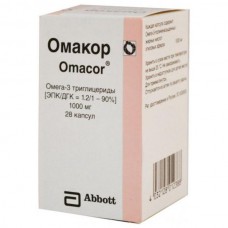Expiration date: 10/2026
The composition and form of issue:
Gelatine capsule. 1 capsule contains:
ethyl ester omega-3 acids consisting of ethyl ester of eicosapentaenoic acid (EPA) is 46% ethyl ester of docosahexaenoic acid (DHA) is 38% 1000 mg
alpha-tocopherol 4 mg
the composition of the shell: gelatin glycerol purified water
in polyethylene bottles of 28 and 100 PC.
Description pharmaceutical form:
Transparent soft gelatin capsule of size 20, the contents of capsules — oily liquid light yellow color.
Feature:
Contains polyunsaturated fatty acids omega-3 — EPA and DHA — essential (essential) fatty acids.
Pharmacokinetics:
During and after the intake of fatty acids omega-3 are 3 main ways of their metabolism:
- fatty acids are delivered first to the liver, where they are included in the various categories of lipoproteins and directed to the periphery of lipids
- phospholipids cell membrane phospholipids are replaced by lipoprotein, after which fatty acids act as precursors of different eicosanoids
- most fatty acids oxidized to provide energy needs.
The concentration of fatty acids omega-3 — EPA and DHA — phospholipids in the plasma concentration of EPA and DHA to be included in the composition of cell membranes.
Description pharmacological action:
Omacor reduces the amount of triglycerides by reducing the concentration of VLDL, in addition, he actively influences on hemostasis by reducing synthesis tromboksana A2 and slightly increasing blood coagulation time.
Delays synthesis of triglycerides in the liver because EPA and DHA inhibit esterification of other fatty acids. The decrease in the level of triglycerides also contributes to reducing the amount of free fatty acids (increase in peroxisomes beta-oxidation of fatty acids) involved in the synthesis of triglycerides.
The increase in HDL is very small and is not permanent. It is much less than that after taking fibrates.
The results of observations (for 3.5 years) of patients taking 1 g Omacor per day showed a significant reduction in the combined outcome including all-cause mortality and nonfatal myocardial infarction and stroke.
Indications:
- secondary prevention of myocardial infarction (in combination with other standard methods of treatment: statins, anti-aggregating means, beta-adrenoblokatorami, ACE inhibitors)
- hypertriglyceridemia: endogenous hypertriglyceridemia as a Supplement to the diet with its lack of effectiveness:
- type IV (monotherapy),
- type IIb/III (in combination with statins, when the concentration is high triglycerides).
Contraindications:
- hypersensitivity to the drug
- exogenic hypertriglyceridemia (type 1 hyperchylomicronemia)
- pregnancy
- the period of breastfeeding.
With caution:
- the age of 18 years (efficacy and safety not established)
- old age (over 70 years)
- marked disorders of liver function
- concurrent use with fibrates or oral anticoagulants
- serious injury
- surgery (due to risk of increased bleeding time).
Application of pregnancy and breast-feeding:
Contraindicated in pregnancy. At the time of treatment should stop breastfeeding.
Side effects:
The frequency of side effects is distributed in the following order: often (1-10%) uncommon (0,1–1%) rare (0.01 and 0.1%) very rare (<0,01%) including isolated reports of side effects.
Infectious processes: rarely, gastroenteritis.
The immune system: infrequently — hypersensitivity.
The metabolic and nutritional: rarely — hyperglycemia.
From the nervous system: rare — dizziness, dysgeusia (dysgeusia) is rare — headache.
Vascular disorders: very rare — decrease in blood pressure.
On the part of the respiratory system, chest and mediastinum disorders: very rare — dryness of the nose.
By the blood: often — neuralgia, nausea uncommon — abdominal pain, gastrointestinal disorder, gastritis, pain in the upper abdomen very rarely — bleeding from the lower GI tract.
Hepatic: rarely — infringements of function of a liver.
The skin and subcutaneous fat: rarely: acne, rash pruritic very rare — urticaria.
In the course of research: very rarely, there was an increase in the number of blood leukocytes, lactate dehydrogenase, blood. Patients with hypertriglyceridemia have reported a moderate increase of transaminases (AST, ALT).
Posts about rare side effects.
Disorders of metabolism and nutrition: the increase in insulin requirements (the need to increase the standard dose).
Violations of the liver: increased liver enzymes.
Violations of the skin and subcutaneous tissue: rosacea, rashes, redness/erythema, rash in the chest, neck and shoulders.
The studies noted few reports on the increase in the level of creatine kinase in the blood, myalgia, increase in AST, ALT, increase in body weight.
Drug interactions:
While the use of oral anticoagulants — increase risk of bleeding time. The appointment of Omacor with warfarin does not result in any hemorrhagic complications. However, when combined admission of Omacor and coumadin or termination of the course of treatment with Omacor requires control of prothrombin time.
Not recommended simultaneous application of fibratami.
Method of application and dose:
Inside, along with food. For secondary prevention of myocardial infarction it is recommended to take 1 capsule. a day. Duration of treatment on the advice of a doctor.
Hypertriglyceridemia: initial dose of 2 caps. a day. In the absence of a therapeutic effect may increase the dose to 4 caps. a day. Duration of treatment on the advice of a doctor.
Overdose:
Symptoms: may cause side effects or worsening of their symptoms.
Treatment: symptomatic therapy.
Precautions:
Has no effect on the ability to driving and maintenance of vehicles.
Special instructions:
In connection with the moderate increase in bleeding time (when you receive a high — dose-4 CBSA.) required monitoring of patients undergoing anticoagulant therapy, and if necessary — the appropriate dose adjustment of anticoagulant. This therapy does not preclude the need for conventional treatment in such patients control. Should take into account the increase in bleeding time in patients with increased risk of hemorrhage (severe trauma, surgery, etc.). Existing research experience in secondary endogenous hypertriglyceridemia (especially uncontrollable diabetes) is very limited. There is no clinical experience in the treatment of hypertriglyceridemia in combination with fibrates. Before omakora may moderate increased activity "liver" transaminases. In patients with impaired liver function (especially when taking high — dose-4 CBSA.) requires regular monitoring of liver function (AST and ALT). Data on use of Omacor in children, elderly patients older than 70 years or in patients with hepatic impairment are not available. In patients with impaired renal function dose adjustment is not required.


